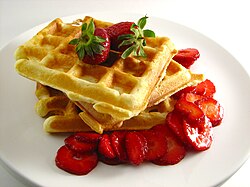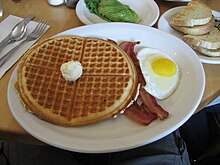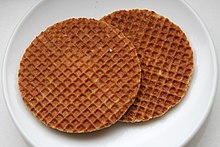Waffle
 Waffles with strawberries | |
| Type | Sweet bread |
|---|---|
| Main ingredients | Batter or dough |
| Variations | American waffle, Belgian waffle, Liège waffle, Bergische waffle, Hong Kong style waffle, Pandan waffls, Scandinavian style waffle, Stroopwafel |





A waffle is a batter-based cake cooked in a waffle iron patterned to give both a characteristic shape and surface impression. There are many variations based on the type and shape of the iron and the recipe used, with over a dozen regional varieties in Belgium alone[1].
Waffles are eaten throughout the world, particularly in Belgium, France, Netherlands, and the United States.
Etymologies
Wafer and waffle share common etymological roots. Wafre ("wafer") occurs in Middle English by 1377, adopted from Middle Low German wâfel, with the l changed to r. Modern Dutch wafel, French gaufre, and German Waffel (cheese), all meaning "waffle", share the same origin, probably. [citation needed] The Dutch form, wafel, was adopted into modern American English as waffle in the 18th century.[2][3]
History
Medieval origins
The modern waffle has its origins in the wafers—very heavy thin crisp cakes baked between wafer irons—of the Middle Ages in the Province of Brabant (modern-day Belgium)[4][5][2] In 14th-century England, wafers were sold by street vendors called waferers.[6] The modern waffle is a leavened form of wafer. Wafer irons consisted of two metal plates connected by a hinge, with each plate connected to an arm with a wooden handle. The iron was placed over a fire and flipped to cook both sides of the wafer. The irons were used to produce a variety of different flat, unleavened cakes, usually from a mixture of barley and oats, instead of the white flour used today.
16th-19th Centuries
High wheat prices in the late 16th and early 17th century [7] continued to keep wheat flour out of reach, and while European waffle bakers still relied on more common grains like spelt, buckwheat, and oats for the their waffles, Belgian waffle chefs were known to finish their baked waffles with melted butter and sugar, another great luxury of the day[8][9].
By the early 18th century, both roughly refined wheat flour[10] and Caribbean sugar were in common use[11][12] in the preparation of waffles. However luxurious, for the time, waffles were still fairly simple unleavened cakes, consisting mostly of flour, butter, sugar and cream/milk.
Waffle preparations evolved rapidly from the mid-18th century onward - from the introduction of cinnamon[13] to waffles becoming leavened with egg whites, ale yeast, ales and champagnes, they were often flavored with orange blossoms, Madeira wine, limes and nuts.[14] Many cookbooks of the time overtly classify them as pastries.
Varieties of waffles
- Brussels waffles[15] are prepared with a yeast-leavened batter, traditionally an ale yeast [16]. They are lighter, crispier and have larger pockets compared to other European waffle varieties, and are easy to differentiate from Liège Waffles by their rectangular sides. In Belgium, most waffles are served warm by street vendors and dusted with confectioner's sugar, though in tourist areas they might be topped with whipped cream, soft fruit or chocolate spread (a practice considered 'inauthentic' by some local connoisseurs). Variants of the Brussels waffles - with whipped and folded egg whites cooked in large rectangular forms - date from the 18th century[17]. However, the oldest recognized reference to "Gaufres de Bruxelles" (Brussels Waffles) by name is attributed from 1842/43 to Florian Dacher, a Swiss baker in Ghent, Belgium, who had previously worked under pastry chefs in central Brussels[18]. Philippe Cauderlier would later publish Dacher's recipe in the 1874 edition of his recipe book "La pâtisserie et la confiture". Maximilien Consael, another Ghent chef, had claimed to have invented the waffles in 1839, though there's no written record of him either naming or selling the waffles until his participation in the 1856 Brussels Fair.[19][20]
- The Liège waffle[21] (from the city of Liège, in eastern Belgium) is a richer, denser, sweeter, and chewier waffle. Invented by the chef of the prince-bishop of Liège in the 18th century as an adaptation of brioche bread dough, it features chunks of pearl sugar which caramelize on the outside of the waffle when baked. It is the most common type of waffle available in Belgium and prepared in plain, vanilla and cinnamon varieties by street vendors across the nation.
- Flemish waffles, or Gaufres à la Flamande, are a specialty of northern France and portions of western Belgium.[22] They’re the first recorded yeasted waffles, pre-dating the Brussels waffle by roughly a century.[23] The original recipe, published in 1740 by Louis-Auguste de Bourbon in Le Cuisinier Gascon, is as follows: Take “deux litrons” (1.7 litres or 7 cups) of flour and mix it in a bowl with salt and one ounce of brewer's yeast barm. Moisten it completely with warm milk. Then whisk fifteen egg whites and add that to the mixture, stirring continuously. Incorporate “un livre” (490 grams or 1.1 pounds) of fresh butter, and let the batter rise. Once the batter has risen, take your heated iron, made expressly for these waffles, and wrap some butter in a cloth and rub both sides of the iron with it. When the iron is completely heated, make your waffles, but do so gently for fear of burning them. Cooked, take them out, put them on a platter, and serve them with both sugar and orange blossom water on top.[24]
- American waffles[25] vary significantly, but are often made from a batter leavened with baking powder and may be round, square, or rectangular in shape. They are usually served as a sweet breakfast food, topped with butter and maple syrup, bacon, and other fruit syrups, honey, or powdered sugar. They are also found in many different savory dishes, such as fried chicken and waffles or topped with kidney stew.[26] They may also be served as desserts, topped with ice cream and various other toppings. They are generally denser and thinner than the Belgian waffle. Waffles were first introduced to North America in 1620 by Pilgrims who brought the method from Holland. Thomas Jefferson brought a waffle iron from France, and waffle frolics or parties became popular in the late 17th century.
- Belgian waffles are a North American type of waffle identified by its larger size, lighter batter and higher grid pattern which forms deep pockets and has larger squares than standard American waffles. Despite its name, the "Belgian waffle" does not exist in Belgium. It is somewhat similar to the Brussels waffle, but Brussels waffles are hard and crispy on the outside. As opposed to a traditional North American waffle, the Belgian waffle attributes its height to the use of yeast batter instead of a pancake batter.[27] Toppings vary from whipped cream, confectioners sugar, soft fruit, chocolate spread, to syrup and butter or margarine. Alternatively, they are served with vanilla ice cream and fresh fruit (such as strawberries) as a dessert. The waffles were popularized in the United States during the 1964 New York World's Fair[27] by Maurice Vermersch of Brussels, Belgium, and was named the Bel-Gem Waffle. Largely based on a simplified recipe for the Brussels waffles, Vermersch decided to change the name upon observing the poor geographical skills of Americans.[28]
- Bergische waffles, or Waffles from Berg county,[29] are a specialty of the German region of Bergisches Land. The waffles are crisp and less dense than Belgian waffles, always heart shaped, and served with cherries, cream and optionally rice pudding as part of the traditional afternoon feast on Sundays in the region.
- Hong Kong style waffle, in Hong Kong called a "grid cake" or "grid biscuits" (格仔餅), is a waffle usually made and sold by street hawkers and eaten warm on the street.[30] It is similar to a traditional waffle but larger, round in shape and divided into four quarters. It is usually served as a snack. Butter, peanut butter and sugar are spread on one side of the cooked waffle, and then it is folded into a semicircle to eat. Eggs, sugar and evaporated milk are used in the waffle recipes, giving them a sweet flavor. They are generally soft and not dense. Traditional Hong Kong style waffles are full of the flavor of yolk. Sometimes different flavors, such as chocolate and honey melon, are used in the recipe and create various colors. Another style of Hong Kong waffle is the eggette or gai daan jai (鷄蛋仔), which have a ball-shaped pattern.
- Pandan waffles originate from Vietnam and are characterized by the use of pandan flavoring and coconut milk in the batter.[31] The pandan flavoring results in the batter's distinctive spring green color.[32] When cooked, the waffle browns and crisps on the outside and stays green and chewy on the inside. Unlike most waffles, pandan waffles are typically eaten plain.
- Scandinavian style waffles, common throughout the Nordic countries, are thin, made in a heart-shaped waffle iron. The batter is similar to other varieties. The most common style are sweet, with whipped or sour cream and strawberry or raspberry jam, or berries, or simply sugar, on top.
- In Norway, brunost is also a popular topping. As with crèpes, there are those who prefer a salted style with various mixes, such as blue cheese.
- In Finland, savory toppings are uncommon; instead jam, sugar, whipped cream or vanilla ice cream are usually used.
- In Iceland, the traditional topping is either rhubarb or blueberry jam with whipped cream on top. Syrup and chocolate spread are also popular substitutes for the jam.
- The Swedish tradition dates at least to the 15th century, and there is even a particular day for the purpose, Våffeldagen (waffle day), which sounds like Vårfrudagen ("Our Lady's Day"), and is therefore used for the purpose. This is March 25 (nine months before Christmas), the Christian holiday of Annunciation.[33]
- Stroopwafels are thin waffles with a syrup filling. They were first made in Gouda in the Netherlands during the 18th or 19th century. The stiff batter for the waffles is made from flour, butter, brown sugar, yeast, milk, and eggs. Medium-sized balls of batter are put on the waffle iron. When the waffle is baked and while it is still warm, it is cut into two halves. The warm filling, made from syrup, brown sugar, butter, and cinnamon, is spread in between the waffle halves, which glues them together.[34] They are popular in Belgium and the Netherlands and sold in pre-prepared packages from local supermarkets.
Waffle toppings
Waffles can be eaten plain (especially the thinner kinds) or sprinkled with powdered sugar. Depending on the region they may be eaten with various toppings such as:
- butter,
- chocolate chips,
- dulce de leche
- fruits:
- bananas,
- blueberries,
- boysenberries,
- raspberries,
- blackberries,
- strawberries, etc.,
- honey,
- jam or jelly,
- Nutella,
- peanut butter,
- syrup:
Ice cream cones are also a type of waffles or wafers. Waffles with ice cream cones are the favorite desserts of the European food activists. The other classical type is a waffle with cheese and kiwifruit as toppings.
See also
References
- ^ "Les Gaufres Belges"
- ^ a b Oxford English Dictionary
- ^ Merriam-Webster
- ^ Néo-physiologie du goût par ordre alphabétique ou Dictionnaire général de la cuisine française et moderne, Bureau du Dictionnaire général de cuisine, Paris, 1839, p. 253
- ^ Pierre Lacam, Le Mémorial historique et géographique de la pâtisserie, 9e éd., Paris, 1911, 866 p., p. 375 and 299.
- ^ References from Chaucer to wafers and waferers from The Miller's Tale and The Pardoner's Tale
- ^ "The Price Revolution in the 16th Century: Empirical Results from a Structural Vectorautoregression Model"
- ^ Carel Baten (Carolus Battus), Eenen seer schoonen ende excellenten Cocboeck, first edition, Dordrecht 1593.
- ^ Carel Baten (Carolum Battum), Eenen seer schoonen ende excelenten Cock boeck, sixth edition, Amsterdam 1624
- ^ Flour From Mill to Market, Tom Kelleher, Food History News, Vol. VI, No. 2, p.2.
- ^ "Dictionaire pratique du bon menager de campagne et de ville", French, pp 399-400, 1715
- ^ "Le nouveau théâtre d'agriculture et Ménage des champs", French, p 634, 1723
- ^ De Volmaakte Hollandsche Keuken-Meid, third edition, Chapter II, Wafelen, hoe men die bakken zal, p. 47, Steven Esveldt, Amsterdam 1752. Internet Edition of the digital library for Dutch literature , Leiden 2003.
- ^ "Le cuisinier royal: ou l'Art de faire la cuisine, la patisserie et tout ce qui concerne l'office", French, pp 391-392, 1820
- ^ "Brussels Waffle recipe", Eddy van Damme, 2012-07-14
- ^ "Een nieuwe, royale oud-Belgische hoofdstedelijke wafel?", faro | tijdschrift over cultureel erfgoed, Belgium (in Flemish), pp 14-21, 03/03/2008
- ^ [“le de brusselier”, “Petite histoire de la cuisine”]
- ^ [[ http://www.deswaene.be/Brusselse%20wafels.pdf, “Om te backen, dicke wafelen”]]
- ^ [WAFELS , “Henk Werk”]
- ^ Lonely Planet Encounter Guide Brussels, Bruges, Antwerp & Ghent 1st edition, 2008, page 151
- ^ "Liège waffle recipe". Fourman.dsl.pipex.com. Retrieved 2012-05-02.
- ^ "La Gaufre Flamande Fourrée", M. Bounie, Polytech’Lille-Département IAA, p 6, 2003/2004
- ^ [WAFELS , “Henk Werk”]
- ^ [ http://books.google.ca/books?id=Sso_PU3u-KcC&pg=PA159&lpg=PA159&dq=%22+Le+cuisinier+gascon%22+gaufre&source=bl&ots=60Junw4TJP&sig=QVPu7ISyGNiOKuxnEgeWyqvW40U&hl=en&sa=X&ei=iY8hUNXHI4fH0QGfnYCIBA&ved=0CGMQ6AEwAA#v=onepage&q=%22%20Le%20cuisinier%20gascon%22%20gaufre&f=false “Le Cuisinier Gascon”, Louis-Auguste de Bourbon, Amsterdam, p 159, 1740]
- ^ "American waffle recipe". Lonestar.texas.net. Retrieved 2012-05-02.
- ^ Davidson, Alan (1999). The Oxford Companion to Food. Oxford: Oxford University press. pp. xx + 892. ISBN 0-19-211579.
{{cite book}}: Check|isbn=value: length (help); Cite has empty unknown parameter:|coauthors=(help) - ^ a b Roberts, Sam (2008-07-27). "A Fair, a Law and the Urban Walker". The New York Times. Retrieved 2009-03-19.
- ^ "His waffles made memories at the Queens World's Fair". Newsday. 1989-08-22.
{{cite news}}:|access-date=requires|url=(help) - ^ rga-online, Remscheid, Germany. "Bergish Waffle recipe" (in Template:De icon). Bergisches-wiki.de. Retrieved 2012-05-02.
{{cite web}}: CS1 maint: multiple names: authors list (link) CS1 maint: unrecognized language (link) - ^ Name (required) (2008-01-23). "Descriptions of Hong Kong Waffles". Mrnaomi.wordpress.com. Retrieved 2012-05-02.
- ^ Katharine Shilcutt (July 2, 2011). "100 Favorite Dishes: No. 81, Pandan Waffles at Parisian Bakery III". Retrieved November 5, 2011.
- ^ Hong & Kim (January 15, 2011). "Pandan Waffles Banh Kep La Dua". Retrieved November 5, 2011.
- ^ Waffle Day in Sweden notice from Radio Sweden
- ^ Stroopwafels. Traditional delicacys. Retrieved on 2008-01-02
External links
 The dictionary definition of waffle at Wiktionary
The dictionary definition of waffle at Wiktionary Media related to Waffles at Wikimedia Commons
Media related to Waffles at Wikimedia Commons- Waffle recipes in the Cookbook wikibook
